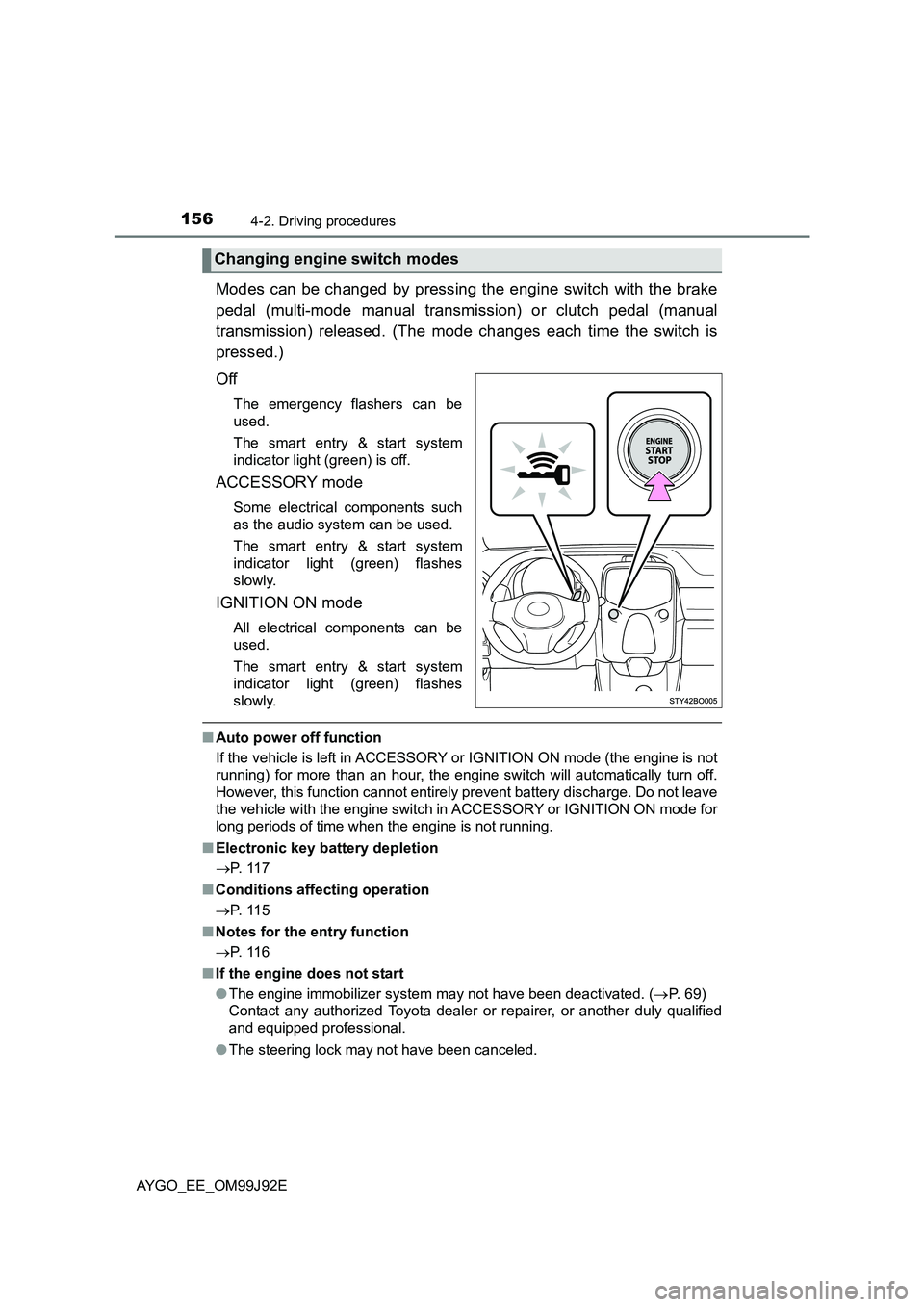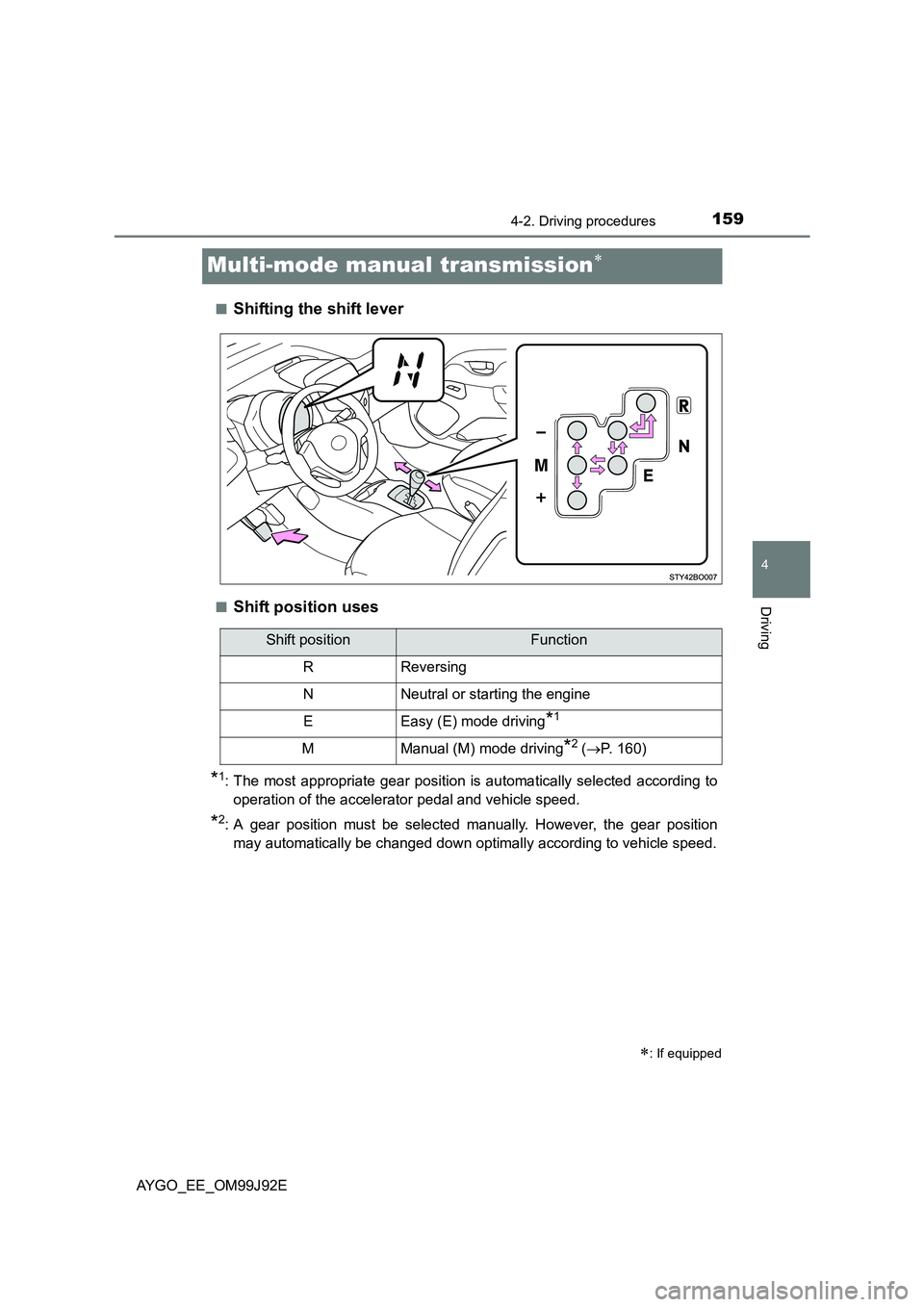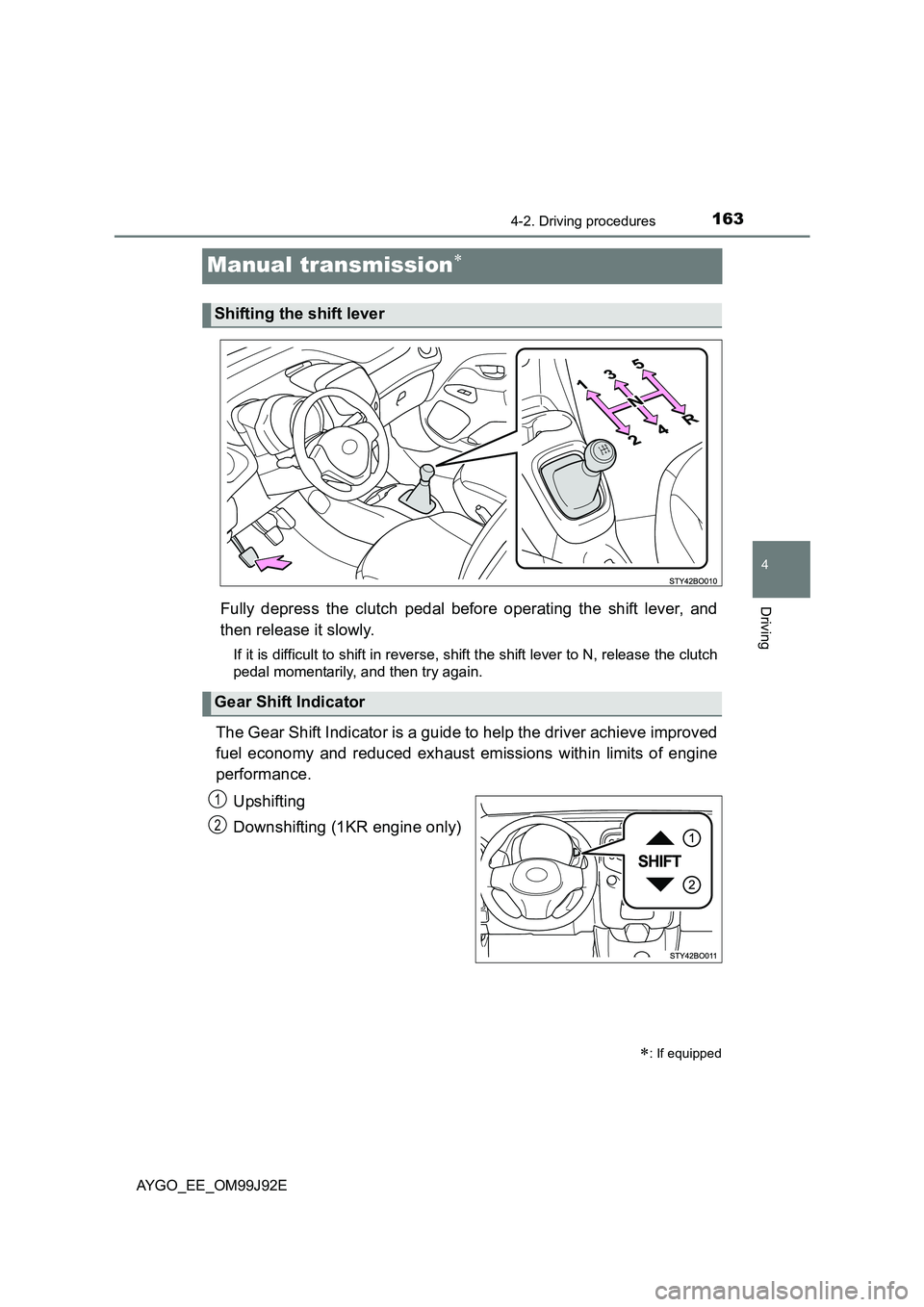2015 TOYOTA AYGO manual transmission
[x] Cancel search: manual transmissionPage 156 of 440

1564-2. Driving procedures
AYGO_EE_OM99J92E
Modes can be changed by pressing the engine switch with the brake
pedal (multi-mode manual transmission) or clutch pedal (manual
transmission) released. (The mode changes each time the switch is
pressed.)
Off
The emergency flashers can be
used.
The smart entry & start system
indicator light (green) is off.
ACCESSORY mode
Some electrical components such
as the audio system can be used.
The smart entry & start system
indicator light (green) flashes
slowly.
IGNITION ON mode
All electrical components can be
used.
The smart entry & start system
indicator light (green) flashes
slowly.
■ Auto power off function
If the vehicle is left in ACCESSORY or IGNITION ON mode (the engine is not
running) for more than an hour, the engine switch will automatically turn off.
However, this function cannot entirely prevent battery discharge. Do not leave
the vehicle with the engine switch in ACCESSORY or IGNITION ON mode for
long periods of time when the engine is not running.
■ Electronic key battery depletion
→ P. 11 7
■ Conditions affecting operation
→ P. 11 5
■ Notes for the entry function
→ P. 11 6
■ If the engine does not start
● The engine immobilizer system may not have been deactivated. (→P. 69)
Contact any authorized Toyota dealer or repairer, or another duly qualified
and equipped professional.
● The steering lock may not have been canceled.
Changing engine switch modes
Page 159 of 440

159
4
4-2. Driving procedures
Driving
AYGO_EE_OM99J92E
Multi-mode manual transmission∗
■Shifting the shift lever
■Shift position uses
*1: The most appropriate gear position is automatically selected according to
operation of the accelerator pedal and vehicle speed.
*2: A gear position must be selected manually. However, the gear position
may automatically be changed down optimally according to vehicle speed.
∗: If equipped
Shift positionFunction
RReversing
NNeutral or starting the engine
EEasy (E) mode driving*1
MManual (M) mode driving*2 ( →P. 160)
Page 162 of 440

1624-2. Driving procedures
AYGO_EE_OM99J92E
■ If the driver’s door is opened when the shift lever is in a position other
than N and the engine is running
A buzzer will sound. Close the driver’s door.
■ If the parking brake is set when the shift lever is in a position other than
N with engine running
● When the driver’s door is opened
A buzzer will sound and the gear position will automatically change to N in
10 seconds.
● When the driver’s door is closed
A buzzer will sound and the gear position will automatically change to N in
90 seconds.
■ If the M indicator does not come on even after shifting the shift lever to M
This may indicate a malfunction in the multi-mode manual transmission sys-
tem. Have the vehicle inspected by any authorized Toyota dealer or repairer,
or another duly qualified and equipped professional immediately.
(In this situation, the vehicle will operate as if the shift lever is in E.)
■ If the N indicator is flashing
● When shifting the shift lever:
Shift the shift lever to N. Wait a few seconds and shift the shift lever to the
desired position.
● When the engine is turned off:
Vehicles without a smart entry & start system:
Turn the engine switch to the “ON” position and shift the shift lever to N, and
then to the desired position.
Vehicles with a smart entry & start system:
Turn the engine switch to IGNITION ON mode and shift the shift lever to N,
and then to the desired position.
If the indicator still blinks after the above operations, shift the shift lever to N
and start the engine. Then, shift the shift lever to the desired position.
■ If the N indicator is flashing and the warning buzzer is beeping
Shift the shift lever to N, and then to E, M or R.
■ Reverse warning buzzer
When shifting into R, a buzzer will sound to inform the driver that the shift
lever is in R.
WARNING
■ Gear Shift Indicator display
For safety, the driver should not look onl y a the display. Refer to the display
when it is safe to do so while considering actual traffic and road conditions.
Failure to do so may lead to an accident.
Page 163 of 440

163
4
4-2. Driving procedures
Driving
AYGO_EE_OM99J92E
Manual transmission∗
Fully depress the clutch pedal before operating the shift lever, and
then release it slowly.
If it is difficult to shift in reverse, shift the shift lever to N, release the clutch
pedal momentarily, and then try again.
The Gear Shift Indicator is a guide to help the driver achieve improved
fuel economy and reduced exhaust emissions within limits of engine
performance.
Upshifting
Downshifting (1KR engine only)
∗: If equipped
Shifting the shift lever
Gear Shift Indicator
1
2
Page 193 of 440

1934-5. Using the driving support systems
4
Driving
AYGO_EE_OM99J92E
■Sounds and vibrations caused by the ABS, brake assist, VSC and TRC
systems
● A sound may be heard from the engine compartment when the engine is
started or just after the vehicle begins to move. This sound does not indicate
that a malfunction has occurred in any of these systems.
● Any of the following conditions may occur when the above systems are
operating. None of these indicates that a malfunction has occurred.
• Vibrations may be felt through the vehicle body and steering.
• A motor sound may be heard after the vehicle comes to a stop.
• The brake pedal may pulsate slightly after the ABS is activated.
• The brake pedal may move down slightly after the ABS is activated.
■ EPS operation sound
When the steering wheel is operated, a motor sound (whirring sound) may be
heard. This does not indicate a malfunction.
■ Automatic reactivation of TRC and VSC systems
After turning the TRC and VSC systems off, the systems will be automatically
reactivated in the following situations:
● When the engine switch is turned to the “LOCK” position (vehicles without a
smart entry & start system) or off (vehicles with a smart entry & start sys-
tem).
● If only the TRC system is turned off, the TRC will turn on when vehicle
speed increases
If both the TRC and VSC systems are turned off, automatic reactivation will
not occur when vehicle speed increases.
■ Reduced effectiveness of the EPS system
The effectiveness of the EPS system is reduced to prevent the system from
overheating when there is frequent steering input over an extended period of
time. The steering wheel may feel heavy as a result. Should this occur, refrain
from excessive steering input or stop the vehicle and turn the engine off. The
EPS system should return to normal within 10 minutes.
■ Operating conditions of hill-start assist control
When the following four conditions are met, the hill-start assist control will
operate:
● Vehicles with a multi-mode manual transmission: The shift lever is in a posi-
tion other than N (when starting off forward/backward on an upward incline).
● The vehicle is stopped.
● The accelerator pedal is not depressed.
● The parking brake is not engaged.
Page 194 of 440

1944-5. Using the driving support systems
AYGO_EE_OM99J92E
■ Automatic system cancelation of hill-start assist control
The hill-start assist control will turn off in any of the following situations:
● Vehicles with a multi-mode manual transmission: The shift lever is moved to
N.
● The accelerator pedal is depressed.
● The parking brake is engaged.
● Approximately 2 seconds elapse after the brake pedal is released.
■ Operating conditions of emergency brake signal
When the following three conditions are met, the emergency brake signal will
operate:
● The emergency flashers are off.
● Actual vehicle speed is over 55 km/h (35 mph).
● The brake pedal is depressed in a manner that cause the system to judge
from the vehicle deceleration that this is a sudden braking operation.
■ Automatic system cancelation of emergency brake signal
The emergency brake signal will turn off in any of the following situations:
● The emergency flashers are turned on.
● The brake pedal is released.
● The system judges from the vehicle deceleration that is not a sudden brak-
ing operation.
WARNING
■ The ABS does not operate effectively when
● The limits of tire gripping performance have been exceeded (such as
excessively worn tires on a snow covered road).
● The vehicle hydroplanes while driving at high speed on wet or slick roads.
■ Stopping distance when the ABS is operating may exceed that of nor-
mal conditions
The ABS is not designed to shorten t he vehicle’s stopping distance. Always
maintain a safe distance from the vehicle in front of you, especially in the
following situations:
● When driving on dirt, gravel or snow-covered roads
● When driving with tire chains
● When driving over bumps in the road
● When driving over roads with potholes or uneven surfaces
■ TRC may not operate effectively when
Directional control and power may not be achievable while driving on slip-
pery road surfaces, even if the TRC system is operating.
Drive the vehicle carefully in conditions where stability and power may be
lost.
Page 197 of 440

1974-6. Driving tips
4
Driving
AYGO_EE_OM99J92E
Accelerate the vehicle slowly, keep a safe distance between you and
the vehicle ahead, and drive at a reduced speed suitable to road con-
ditions.
Park the vehicle and move the shift lever to E, M or R (multi-mode
manual transmission) or 1 or R (manual transmission) without setting
the parking brake. The parking brake may freeze up, preventing it
from being released. If necessary, block the wheels to prevent inad-
vertent sliding or creeping.
�XVehicles with 14-inch tires
Use the correct tire chain size when mounting the tire chains.
Chain size is regulated for each tire size.
Side chain:
3 mm (0.12 in.) in diameter
10 mm (0.39 in.) in width
30 mm (1.18 in.) in length
Cross chain:
4 mm (0.16 in.) in diameter
14 mm (0.55 in.) in width
25 mm (0.98 in.) in length
�XVehicles with 15-inch tires
Tire chains cannot be mounted on the 15-inch tires.
Snow tires should be use instead.
Regulations regarding the use of tire chains vary depending on loca-
tion and type of road. Always check local regulations before installing
chains.
When driving the vehicle
When parking the vehicle (in the winter time or in the cold lati-
tudes)
Selecting tire chains
1
2
3
4
5
6
Regulations on the use of tire chains
Page 325 of 440

3257-3. Do-it-yourself maintenance
7
Maintenance and care
AYGO_EE_OM99J92E
13HORN10Horn
14D/C CUT30ECU-B NO.1, ECU-B NO.2, ECU-B NO.3
15ECU-B NO.4*27.5Multi-mode manual transmission
16AM2 NO.27.5Multiport fuel injection system/sequential
multiport fuel injection system
17AM2 NO.37.5Smart entry & start system
18ICS*27.5Charging system
19EFI-MAIN*125EFI NO.3, EFI NO.4, EFI NO.5, RDI
NO.2
20ST30Starting system
21STRG LOCK7.5Steering lock system
22H-LP-MAIN25H-LP RH-LO, H-LP LH-LO, H-LP RH-HI,
H-LP LH-HI
23WIPER-S*27.5Multiport fuel injection system/sequential
multiport fuel injection system
24STA7.5
Multiport fuel injection system/sequential
multiport fuel injection system, starting
system, multi-mode manual transmis-
sion, Stop & Start system
25ECU-B NO.315Audio system, smart entry & start system
26ECU-B NO.17.5Gauges and meters
27ECU-B NO.27.5Vehicle stability control system
28J/B60Instrument fuse box
29ALT*2125
DEF, S/HTR F/R, S/HTR F/L, CANVAS
TOP, ABS NO.1, ABS NO.2, RDI NO.1,
FOG FR, DRL
30AMT*350Multi-mode manual transmission
BBC*440Stop & Start system
31EPS50Electric power steering system
32RDI NO.1
50*1
Electric cooling fan30*5
40*5
FuseAmpereCircuit